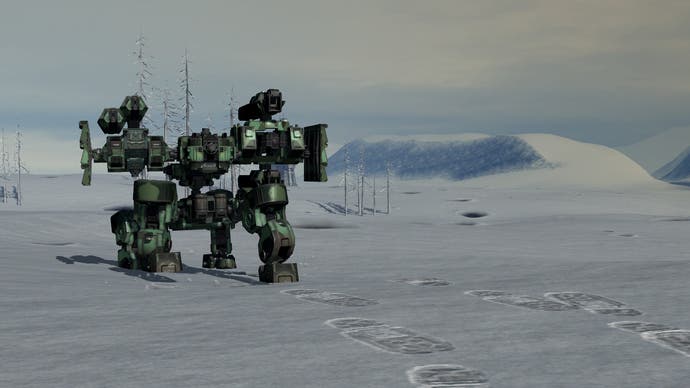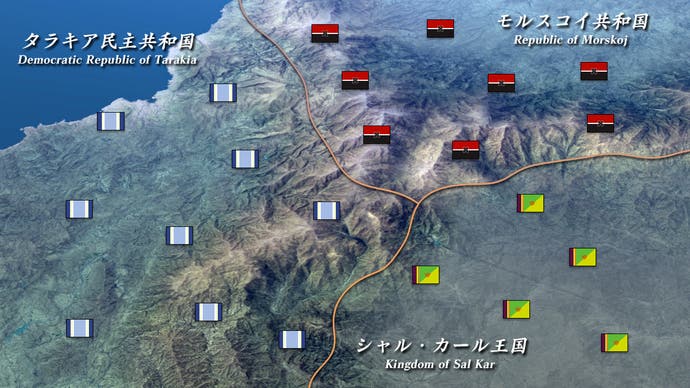Chromehounds
E3: Global war in the meching.
When they say that show floors are a rubbish place to cast judgements around, they're thinking about games like Chromehounds. If ever something's destined to have its point missed by sweltering SEGA-heads, it's FromSoftware's ambitious multiplayer mech game. Because while on the surface it's Armored Core crossed with MechAssault, a few minutes with a demo isn't going to tell the whole story - of a game with similar aspirations to the ludicrous multiplayer war of Steel Battalion: Line of Contact, trying to be unashamedly hardcore without alienating everyone.
It's easier just to say it's some pretty, configurable mechs shooting at each other, and wander onto the next exhibit.
But let's get to that in a moment. Previews need hooks and name-checking mech games probably won't do it. So here's how the general conflict works: you play a role in a team of up to six; your team's job is to secure the map by destroying the enemy or the enemy's base; your team is a bunch of highly customised mechs, probably in your own team-specific war paint, and organisation is a must because if you stumble out of range of the nearest COMBAS communications tower, you're on your own. And the other team's going to be organised too. And the only way out is to hit self-destruct.
Anyway, having spent a solid hour going through the game in minute detail, it's possible to expand upon some of original assumption: that it's pretty, configurable mechs shooting each other. First of all, "pretty". Chromehounds perhaps suffered at the Tokyo Game Show due to the sheer quality of the computer-generated attract sequence that SEGA originally showed at E3 last year. The comparison isn't overly kind. But that's by no means to say it's ugly. Quite the opposite in fact; there are gaps in its veneer, but the things it sets out to do it does expertly.

The hounds - mechs - are superbly detailed, down to the last bolt and cog, and sparks abound as shrapnel splatters and sandy splash damage erupts around you - and visual effects to match the guns. AI-controlled tanks and minor mechs prowl around and radiate warmth from their darkly orange bubbles of exploding technology - and with particular vehemence in dark environments. Thanks to the spectacular draw distance, you can track down firefights by looking for the arcs of fire cutting through the sky, and the detail and depth of the urban environments puts rival 360 titles to shame, with no expense spared to render their undoing - hit a water tower and its contents bath the sand in a soggy shadow, which dissipates with time.
So that's "pretty". Then there's "configurable". FromSoft's experience with Armored Core ought to be a clue here - after all, this is a company that made a PSP game that involves nothing but building mechs and watching them fight.
Rolling your own mech has never looked and felt as authentic as it does in high-definition on Xbox 360. You can select the legs (or tracks, or hover craft mechanics if you like), the type of frame, with weaponry selectable depending on space and funds. With a hexagonal array on each arm you can equip all sorts, and rotate between weapon clusters in-game. As if to prove just how serious they are about the detail, at one point the game's producer, showing off the modifications, tried to add a machinegun to a roof mount only to discover the back end of it overlapped the engine core ever so slightly, ruling out its inclusion. As you'd expect, the range of stats provided for each part is vast - and there's a Pro Evolution Soccer-style six-pointed mech-quality star graphic in the top-right to show you how your mech is balanced in each area. So you can build up a really nice one - although that's providing you don't go over the weight limit, too. Then, once you get bored, you can mix things up again - with downloadable parts due to be made available after release.

Those of a MechAssault bent won't have to go this deep - there's an optional Assembly Guide to walk you through it - but if you want to go really deep then you can edit virtually everything, right down to the colours and your emblem. The emblem's not a sticker that wraps around, either - it's your design projected from whatever angle you like, perfectly viewable from that perspective as though head-on. A bit like the ads angled for the gantry cameras on rugby pitches. FromSoft reckons clans will love this.
So that's "configurable". Which leaves the mechs shooting at each other. A funny thing, too, since if you leave them shooting each other you'll lose the war.
But I'm getting ahead of myself. Offline, first of all, you're treated to a pretty sizable campaign. There are six classes in the game - soldier, sniper, defender, scout, heavy gunner and commander - with seven missions for each and a final boss, and the missions will gradually introduce you to the disciplines required to handle each type of mech (remember, there's scope for configuration wherever you head), ramping up in difficulty as it goes. Initially you're loaned a hound and parts because you can't afford much, and the story's the same if you want to go online without grafting your way through the single-player, too. Pre-rolled may be fine. From my perspective it wasn't a problem anyway - SEGA's QA department made me a shiny green fellow with a ridiculously powerful cannon and speedy caterpillar tracks. Muahaha.
Once you're in the fray you're able to roll around with the left stick, aim with the right, and switch between third and first-person views by clicking in the right thumb-stick. Whichever viewpoint you're not using is shown window-in-window in the top-right. You certainly make plenty of use of both though, because while third-person is handy for keeping an eye on your surroundings, navigating terrain and so on, first offers gun-sights. With which you'll have plenty of things to aim at.

Although there's a big single-player campaign, and it's possible to solo online to a certain extent - or fill in the blanks with AI-controlled mechs - the real object is to conquer the world. To actually conquer it. Pick-up games are possible, but the main focus is called the Neromius War - a revolving conflict of push and pull, offering the kind of scale to the multiplayer mode that Steel Battalion reached for before it stumbled over the weight of its inherent catch-22. Well, both of them.
Which is to say that the Neromius War is a screen of flag icons spread over three nations, with three factions fighting for their control. Each flag represents a clutch of battlegrounds you can enter and try and influence, but eventually someone wins. The first side to be completely suppressed can choose exile or asylum - mercenary duties, effectively - with one of the other two. And once the war is completely resolved, the next war starts. The limit for individual battles is six versus six, but squads (clans) can support up to 20, so a concerted evening-long offensive could steamroller the disorganised.
Naturally then it's about team-play. There are variations on the conditions, but on the whole the basic game we were introduced to made sense by itself - and the COMBAS tower control angle is quite ingenious. Each one and its ownership is marked on the satellite view you can bring up by pressing the Y button, and capturing them is a case of moving close to them for a short while - as with the flags in Battlefield. Once under your control, the COMBAS tower creates a bubble within which communications are possible, whether via voice or through selectable pre-set commands you can access with the d-pad. If you stray outside the COMBAS bubble, you have no direct communications, which is a problem. And just because you own COMBAS towers on opposite sides of the map doesn't mean the two areas can communicate; you need to connect the bubbles through overlapping. In a game of six versus six with some 15-20 COMBAS towers, positioning is likely to play a big role, and a good balance of classes - faster scouts, consolidation from heavy gunners - equally important.

Another layer of help comes from the commander class. Commanders can talk to the troops and, obviously, issue orders - but they can also act as their own small, portable COMBAS towers. By positioning one between two separate comms bubbles, they can act as a bridge - like the soldier clutching two ends of telegraph wire with signals pumping through his corpse.
From our experience playing it, combat is highly tactical. High ground is very valuable, for example, but if you stand up there and then try machinegunning or firing weak rocket salvos, a skilled sniper or decently competent missile launcher will be able to take you down regardless. And while speed may be your friend out in the open, in urban environments it can see you careening awkwardly into structures you're forced to expend ammo on to remove. Each of your mech's component parts has a specific durability rating too, so it's rarely a foregone conclusion - a skilful or even lucky shot to the right area can be crippling, taking out weapon arrays, and a misstep on a mountainside can impede your manoeuvrability by damaging the legs once you drop. But, for every Ying there's a Yang - in the shape of equippable glider parts and so on.
Ultimately Chromehounds is likely to be one of two things: a victim of its scope, or a success because of it. A lot of its popularity online - where it needs to be popular to really mean anything - will probably owe to review scores focusing on single-player. We hope it works out. It has the potential to go wrong, as do all risky endeavours - but it also has the potential to go right, and drag your weekly Ghost Recon crowd into the mechanised future in the process.
Chromehounds is due out on Xbox 360 on July 7th, and should be playable in demo form on Xbox Live Marketplace around now.

